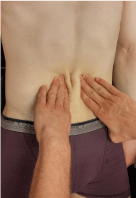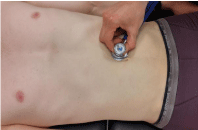
Special Article - Abdominal Aortic Aneurysms
Austin J VascMed. 2016; 3(1): 1013.
Abdominal Aortic Aneurysm, Clinical Tools for Diagnosis in Low Back Pain
Osinski T*
Department of Rheumatology, Hospital Ambroise Pare,France
*Corresponding author: Osinski T, Department of Rheumatology, Hospital Ambroise Pare, 9 avenue Charles de Gaulle, Boulogne Billancourt, France
Received: November 27, 2015; Accepted: January 06,2016; Published: December 28, 2015
Abstract
Introduction: Abdominal aortic aneurysm is a rare but severe cause of low back pain.
Materials and Methods: Here we reviewed the clinical tools that exist to diagnosis this pathology in clinical practice in patient with low back pain
Results: The presence of an abdominal pulsatile mass is a sensitive sign and the auscultation of a bruit in the way of the abdominal aorta is a specific sign for presence of an AAA.
Conclusion: Those two tools permit to identify a severe pathology that can mimic a low back pain and help for the clinical reasoning and differential diagnosis
Keywords: Abdominal aortic aneurysm; Low back pain; Clinical diagnosis
Introduction
The lumbago is a frequent pathology with important consequences on the activities of the affected peoples [1,2]. Several structures can provoke Low Back Pain (LBP) (intervertebral disk, muscle, zygapophyseal joint) [3-5]. Viscera are a part of structures which can provoke a low back pain [6-8]. Among the abdominal structures the abdominal aorta in case of aneurysm, ruptured or not, can be the source of this symptom [9].
If the diameter exceeds 3 cm we talk about aneurysm [10]. This pathology represents a lethal risk in case of break. The lethality of ruptured AAA is around 80 % [11]. This rate of death rises to 100 % in case of no attempt of surgical care [12]. While the rate of death in case of preventive operation of an symptom-free aneurysm at high risk of break is 5 % at one month, and 32.3 % at 6 years [13]. This pathology is the tenth cause of death at the men of more than 65 years and the thirteenth for the women of more than 75 years [14].
This pathology has generally a silent evolution, what makes the diagnosis difficult to do [15]. The prevalence of an AAA in general population varies between less than 1% and more than 7% depends of studies [16,17]. Numerous cases were reported in literature of patient who were addressed to manual therapy for low back pain and were diagnosed with an AAA [9,18-20]. We resume here the evidences about clinical diagnosis of AAA and who are people at risk.
Method
We performed a selective narrative review of clinical relevant literature. We looked for clinical tests useful for the diagnosis of an AAA. Our review was performed on different databases (Medline, Cochrane Library, PEDro). The population of interest was preferentially person with low back pain who were diagnosed with an AAA or people at
risk screen preventively. We regarded to studies which compared clinical diagnosis to a gold standard (ultrasound echography, or MRI) to determine the metrological quality of clinical test for AAA.
Results
Clinical presentation
Low back pain is frequently the main complain of AAA [21]. Numerous cases are reported in literature. Generally the pain is chronic or recurrent in elderly people [18,22-24] but the pain might be more acute in younger people [14,25]. Often patients describe pain as deep and constant. In these patients, consulting for an episode of LBP associated with AAA, generally the clinical examination can't reproduce their complaint. Sometimes patient has abdominal pain but isn't always the case and it's don't seem to be frequent [26,27]. The fact that movement of spine fail to evoke the patient's pain is consider as a red flag for suspicious severe pathology [27]. The presence of an abdominal pulsatile mass is a frequent sign often accompanied by hypotension [9,22].
Clinical testing
The palpation of an abdominal pulsatile mass is a clinical useful tool to rule out an AAA (Figure 1). This test showed a sensitivity of 91 % in the presence of this pathology for subjects with an abdominal perimeter inferior of 100 cm [28]. For patients with an abdominal perimeter superior at 100 cm the sensitivity is 53 % [28]. Globally the sensitivity of palpation varies between studies from 63 % to 95 % [29]. The test's sensitivity is estimated at 29 % if aneurysm has a diameter between 3.0 cm and 3.9 cm. Otherwise the sensitivity increases at 76 % if the diameter of the aneurysm is superior at 5 cm [29].

Figure 1: Palpation to search an abdominal pulsatile mass.
Auscultation is the second clinical tool proposed in literature. Auscultating a breath along the course of abdominal aorta is a high specific test (95 %), a sound can also be detecting on femoral arteries with a high specificity too (85 %) (30).
Discussion
The screening of an AAA is a simple clinical diagnosis which bases on the palpation of an abdominal pulsatile mass. The normal diameter of the abdominal aorta is lower than 3 cm, the estimation of this diameter via an depth palpation in the belly can help to the diagnosis, even if this estimation can be biased by the presence of others structures (Figure 2) [28]. The palpation of an abdominal mass is thus a test with a good sensibility which thus allows eliminating the presence of an aneurysm in case of negative test.

Figure 2: Palpation to estimate the diameter of the abdominal aorta.
To refine the clinical examination it is possible to proceed to the auscultation of the belly. The auscultation of the aorta is made by putting a stethoscope on the route of the artery (Figure 3). It's important to should not push the stethoscope in the belly of the patient, especially if patient is thin because there would be a risk of deforming the artery. Normally the auscultation of the belly has to reveal no sound if it is not digestive noises. In case of aneurysm it is very likely to hear a breath. The presence of a breath has a high specificity and permit to rule in the presence of an aneurysm. The combination of these two tests thus allows making a reliable clinical diagnosis of the need of more exams.
The principle risk factors of AAA are smoking, age, gender, family antecedents, and precedents cardiovascular pathologies [31-35]. Eighty percent of patients with AAA are = 55 years, male have 3 to 13 times more risk to develop an AAA, the effect of tobacco decrease in time to disappear after 20 years of stop [36]. Caucasians are more susceptible to declare this pathology versus Africans, Hispanics and Asians [34,35]. The consumption of vegetables, fruits, nuts and the regular physical exercise can reduced the risk of developed an AAA [28].

Figure 3: Auscultation of the abdominal aorta.
We recommend to practitioners to know these tests and don't forget that this pathology might be the source of patient's symptoms, particularly for people with high risks. Indeed this pathology can mime musculoskeletal pains and seems very sub-diagnosed, only one patient on six would be detected and operated [36].
The surveillance must be more important for persons over 60 years, even if several cases were described at younger patients as the presented case. Furthermore it is necessary to keep in mind that aneurysms of less than 5 cm in diameter may also break [35].
Conclusion
Even if the evolution of the AAA is generally asymptomatic and even if the discovery is generally fortuitous this pathology can mimic lumbago. The diagnosis tools presented here seem to us essential to use in view of their simplicity and the trend to underdiagnose this pathology.
References
- Hoy D, Brooks P, Blyth F, Buchbinder R. The Epidemiology of low back pain. Best Pract Res Clin Rheumatol. 2010; 24: 769-781.
- Manchikanti L, Singh V, Falco FJE, Benyamin RM, Hirsch JA. Epidemiology of low back pain in adults. Neuromodulation J Int Neuromodulation Soc. 2014; 17: 3-10.
- Malanga GA, Cruz Colon EJ. Myofascial Low Back Pain: A Review. Phys Med Rehabil Clin N Am. 2010; 21: 711-724.
- O'Neill CW, Kurgansky ME, Derby R, Ryan DP. Disc stimulation and patterns of referred pain. Spine. 2002; 27: 2776-2781.
- Middleton WI, is Chief H, Datta S, Healthcare TV. Systematic assessment of diagnostic accuracy and therapeutic utility of lumbar facet joint interventions. Pain Physician. 2009; 12: 437-460.
- Troyer MR. Differential Diagnosis of Endometriosis in a Young Adult Woman with Nonspecific Low Back Pain. Phys Ther. 2007; 87: 801-810.
- Weiss DJ, Conliffe T, Tata N. Low back pain caused by a duodenal ulcer. Arch Phys Med Rehabil. 1998; 79: 1137-1139.
- Zuniga Cedo E, Vico Beso L. [Chronic low back pain and abdominal aortic aneurysm]. Semergen Soc Esp Med Rural Generalista. 2013; 39: e47-9.
- Martinez Perez R, La Fuente D, Marenco JL, Rodriguez Montero S, Escudero C. Chronic back pain as the first symptom in the rupture of an abdominal aortic aneurism: presentation of 2 cases. Reumatol Clinica Engl Ed. 2010; 6: 273-274.
- Sakalihasan N, Limet R, Defawe OD. Abdominal aortic aneurysm. The Lancet. 2005; 365: 1577-1589.
- Lindholt JS. Abdominal aortic aneurysms. Dan Med Bull. 2010; 57: B4219.
- Basnyat PS, Biffin AH, Moseley LG, Hedges AR, Lewis MH. Mortality from ruptured abdominal aortic aneurysm in Wales. Br J Surg. 1999; 86: 765-770.
- Johnston KW. Nonruptured abdominal aortic aneurysm: six-year follow-up results from the multicenter prospective Canadian aneurysm study. Canadian Society for Vascular Surgery Aneurysm Study Group. J Vasc Surg. 1994; 20: 163-170.
- Mechelli F, Preboski Z, Boissonnault W. Differential Diagnosis of a Patient Referred to Physical Therapy With Low Back Pain: Abdominal Aortic Aneurysm. J Orthop Sports Phys Ther. 2008; 38: 551-557.
- Becker F, Baud J. The success of a screening program largely depends on how patients are managed after the screening test.… Of great concern for patients with small AAAs detected at screening is the risk of unnecessary procedures. J Mal Vasc. 2006; 31: 260-76.
- Norman PE, Jamrozik K, Lawrence-Brown MM, Le MTQ, Spencer CA, Tuohy RJ, et al. Population based randomised controlled trial on impact of screening on mortality from abdominal aortic aneurysm. BMJ. 2004; 329: 1259.
- Lederle FA. The Rise and fall of Abdominal Aortic Aneurysm. Circulation. 2011; 124: 1097-1099.
- Osinski T. Anevrisme aortique abdominale?: depistage d'une lombalgie mortelle. Etude d'un cas et donnees de la litterature pour le depistage. Kinesitherapie Rev. 2015; 15: 51-52.
- Mechelli F, Preboski Z, Boissonnault W. Differential Diagnosis of a Patient Referred to Physical Therapy With Low Back Pain: Abdominal Aortic Aneurysm. J Orthop Sports Phys Ther. 2008; 38: 551-557.
- Van Wyngaarden JJ, Ross MD, Hando BR. Abdominal Aortic Aneurysm in a Patient with Low Back Pain. J Orthop Sports Phys Ther. 2014; 44: 500-507.
- Jimenez Viseu Pinheiro JF, Blanco Blanco JF, Pescador Hernandez D, Garcia Garcia FJ. Vertebral destruction due to abdominal aortic aneurysm. Int J Surg Case Rep. 2014; 6: 296-299.
- de Boer NJ, Knaap SFC, de Zoete A. Clinical detection of abdominal aortic aneurysm in a 74-year-old man in chiropractic practice. J Chiropr Med. 2010; 9: 38-41.
- Alshafei A, Kamal D. Chronic Contained Abdominal Aortic Aneurysm Rupture Mimicking Vertebral Spondylodiscitis: A Case Report. Ann Vasc Dis. 2015; 8: 113-115.
- Jimenez Viseu Pinheiro JF, Blanco Blanco JF, Pescador Hernandez D, Garcia Garcia FJ. Vertebral destruction due to abdominal aortic aneurysm. Int J Surg Case Rep. 2014; 6: 296-299.
- Kakuta Y, Iizuka H, Kobayashi R, Iizuka Y, Takahashi T, Mohara J, et al. Gorham disease of the lumbar spine with an abdominal aortic aneurysm: a case report. Spine J Off J North Am Spine Soc. 2014; 14: e5-9.
- Wyngaarden JV. Abdominal Aortic Aneurysm in a Patient with Low Back Pain. J Orthop Sports Phys Ther. 2014; 44: 500-507.
- Sizer PS Jr, Brismee J-M, Cook C. Medical screening for red flags in the diagnosis and management of musculoskeletal spine pain. Pain Pract off J World Inst Pain. 2007; 7: 53-71.
- Fink HA, Lederle FA, Roth GS, Bowles CA, Nelson DB, Haas MA. The accuracy of physical examination to detect abdominal aortic aneurysm. Arch Intern Med. 2000; 160: 833-836.
- Lederle F, Simel DL. Does this patient have Abdominal Aortic Aneurysm. JAMA. 1999; 281: 77-82.
- Lederle FA, Walker JM, Reinke DB. Selective screening for abdominal aortic aneurysms with physical examination and ultrasound. Arch Intern Med. 1988; 148: 1753-1756.
- DeRubertis BG, Trocciola SM, Ryer EJ, Pieracci FM, McKinsey JF, Faries PL, et al. Abdominal aortic aneurysm in women: Prevalence, risk factors, and implications for screening. J Vasc Surg. 2007; 46: 630-635.
- Cornuz J, Pinto CS, Tevaearai H, Egger M. Risk factors for asymptomatic abdominal aortic aneurysm. Eur J Public Health. 2004; 14: 343-349.
- Chun KC, Teng KY, Chavez LA, Van Spyk EN, Samadzadeh KM, Carson JG, et al. Risk factors associated with the diagnosis of abdominal aortic aneurysm in patients screened at a regional Veterans Affairs health care system. Ann Vasc Surg. 2014; 28: 87-92.
- Jahangir E, Lipworth L, Edwards TL, Kabagambe EK, Mumma MT, Mensah GA, et al. Smoking, sex, risk factors and abdominal aortic aneurysms: a prospective study of 18 782 persons aged above 65 years in the Southern Community Cohort Study. J Epidemiol Community Health. 2015; 69: 481-488.
- Kent KC, Zwolak RM, Egorova NN, Riles TS, Manganaro A, Moskowitz AJ, et al. Analysis of risk factors for abdominal aortic aneurysm in a cohort of more than 3 million individuals. J Vasc Surg. 2010; 52: 539-548.
- Pertinence de la mise en place d'un programme de depistage des anevrismes de l'aorte abdominale en France. Saint-Denis: Haute Autorite de Sante; 2012.
- Brown LC, Powell JT. Risk Factors for Aneurysm Rupture in Patients Kept Under Ultrasound Surveillance. Ann Surg. 1999; 230: 289-296.